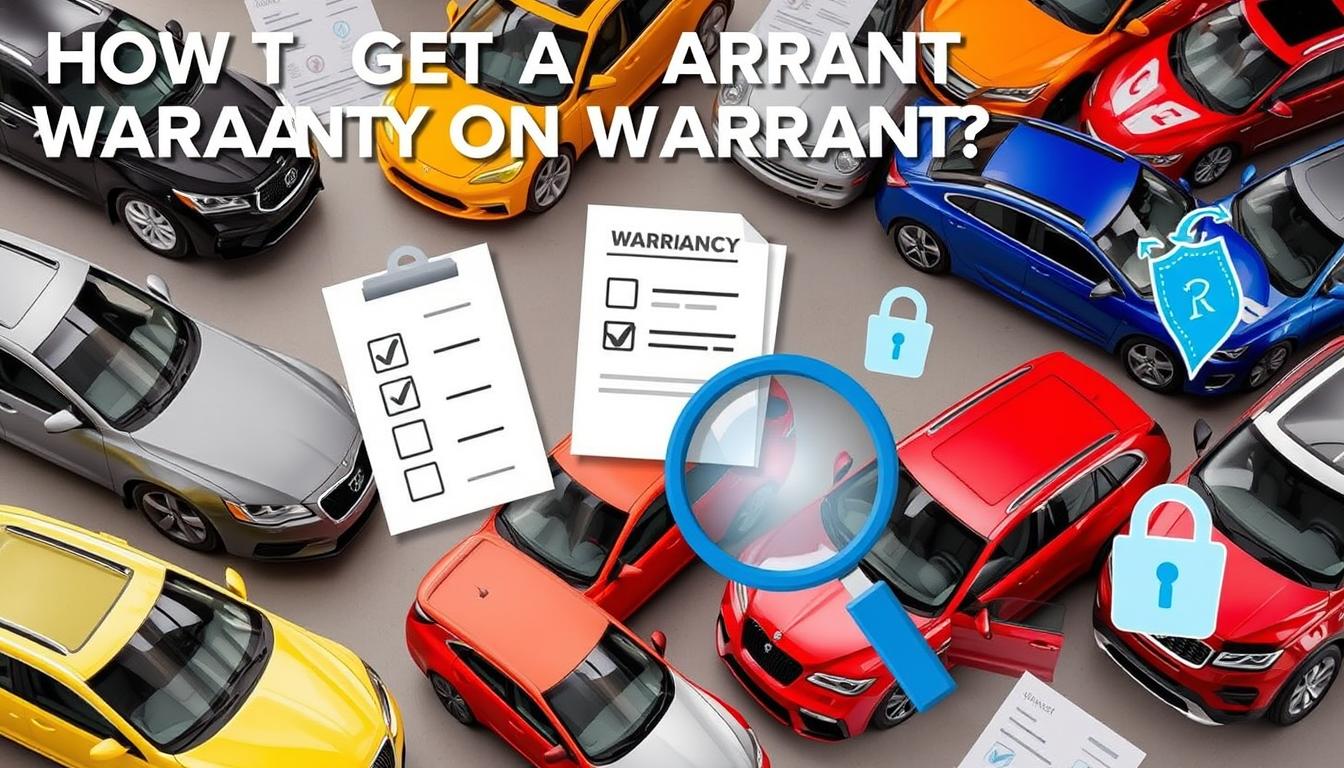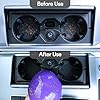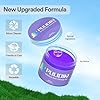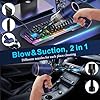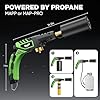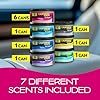Table of Contents
Thinking about buying a used car and wondering about warranties? There are many used car warranty options out there. It’s key to know the different types and their benefits. A warranty can give you peace of mind and protect your investment.
Can you get a manufacturer warranty on a used car? Is an extended warranty worth it? We’ll answer these questions in this article.
Key Takeaways
- Used car warranties can help cover specific repair expenses after purchasing a pre-owned vehicle.
- There are different types of used car warranties, including powertrain warranties, stated-component warranties, and bumper-to-bumper warranties.
- Third-party warranty companies, such as Endurance, CarShield, and CARCHEX, offer various plans with additional benefits like 24/7 roadside assistance and towing.
- When selecting a warranty provider, consider factors like coverage level, affordability, payment options, reputation, and customer service quality.
- A well-chosen used car warranty can mitigate financial risk, provide access to qualified repair facilities, and enhance the vehicle’s resale value.
- It’s crucial to research and compare different warranty providers to find the best option for your needs and budget.
Understanding Used Car Warranty Basics
When you buy a used car, knowing the used car warranty basics is key. This ensures you’re safe from surprise repair and maintenance bills. Used car warranties differ in what they cover, with common types being powertrain and bumper-to-bumper warranties.
There are many types of used car warranties out there. Each offers a different level of protection. Some might ask you to pay a deductible or fee when you file a claim. The coverage levels also vary, with some warranties covering just certain parts or systems, while others offer more all-around protection.
Types of Used Car Warranties Available
- Powertrain warranties, which cover the engine, transmission, and drivetrain
- Bumper-to-bumper warranties, which cover most parts and systems, excluding maintenance items
- Certified pre-owned (CPO) warranties, which are offered by manufacturers for certified used vehicles
Coverage Levels Explained
Coverage levels can range from basic to comprehensive, with varying degrees of protection. It’s important to check the warranty terms and conditions. This way, you’ll know what’s covered and what’s not. Some warranties might also include extra perks, like roadside assistance or rental car coverage.
Common Warranty Terms and Conditions
When looking at a used car warranty, it’s crucial to read the terms and conditions. This includes the coverage period, deductible, and how to file a claim. Knowing these details helps you make a smart choice and protects you from unexpected expenses.
| Warranty Type | Coverage Level | Duration |
|---|---|---|
| Powertrain | Engine, transmission, drivetrain | Up to 5 years or 60,000 miles |
| Bumper-to-bumper | Most parts and systems | Up to 3 years or 36,000 miles |
| CPO | Comprehensive | Up to 7 years or 100,000 miles |
Manufacturer Warranties on Pre-owned Vehicles
When you buy a used car, think about the warranty. Manufacturer warranties give you peace of mind. They cover repairs, which is great for pre-owned vehicles.
Certified pre-owned warranties are also worth looking into. These warranties are made by car makers. They offer extra protection and perks like roadside help and car rentals.
Some car makers, like General Motors, Ford, and Stellantis, have warranties for parts. These last up to 24 months and don’t have a mileage limit. But, these warranties don’t pass to the next owner.
Mercedes-Benz, however, has a warranty that you can pass on. It covers parts and labor for 24 months and unlimited miles.
About 13 states follow California’s rules for used cars. They have special warranties for emissions systems. These can last up to 8 years or 80,000 miles. Also, federal rules require warranties for certain parts for 8 years or 80,000 miles.
| Manufacturer | Warranty Length | Mileage Limit |
|---|---|---|
| General Motors | 24 months | Unlimited miles |
| Ford | 24 months | Unlimited miles |
| Mercedes-Benz | 24 months | Unlimited miles |
Extended Warranty Options for Used Cars
When you buy a used car, think about getting an extended warranty. These warranties offer extra protection after the initial one ends. It’s key to check the details carefully. For used cars, you can choose from dealer-provided warranties or third-party options. They offer different levels and lengths of coverage.
Some people ask, “Is it too late to get a warranty on my car?” or “Can you get a warranty on a used car after buying it?” Yes, you can. Companies like CARCHEX offer extended protection plans. These can last up to 10 years or 250,000 miles. They give you peace of mind and protect your wallet from surprise repairs.
- Can you transfer existing warranties?
- Are there specific repair shops you must use?
- Is the warranty’s cost worth it compared to repair costs?
- How reliable and good is the car’s quality?
Also, do your homework on the warranty provider. Read what other customers say to make a smart choice.
| Warranty Provider | Coverage Duration | Cost |
|---|---|---|
| CARCHEX | Up to 10 years/250,000 miles | $1,000 to $3,000 upfront |
| Dealerships | Varies | Additional cost |
By carefully looking at extended warranty options, you can choose wisely. This way, you can protect your used car and your wallet.
How to Get a Warranty on a Used Car After Purchase
When you buy a used car, think about the warranty options. A used car warranty after purchase can help cover repair costs for faulty parts or manufacturer issues. Used cars often have different warranty choices, like limited warranties from dealers, remaining factory warranties, certified pre-owned warranties, or extended warranties.
To get a warranty on a used car after buying, it’s key to read the terms and conditions well. Here are some steps to take:
- Check if the vehicle still has a remaining factory warranty that can be transferred to the new owner.
- Look into certified pre-owned warranties, which often include additional benefits like roadside assistance.
- Consider purchasing an extended warranty, which can provide coverage for specific components for several years or miles.
Remember, the main benefit of a warranty for a used car is protection from repair costs. Most used vehicles have some warranty, whether it’s from the factory, as a certified pre-owned warranty, or an extended warranty. By knowing the different warranties and reading the terms, buyers can make a smart choice when buying a used car.
In the end, how to get a warranty on a used car after purchase needs careful thought and research. By following these steps and understanding the various warranties, buyers can avoid expensive repairs and have a hassle-free car ownership experience.
Evaluating Warranty Costs and Value
When looking at a used car warranty, it’s key to check the costs and value. The monthly payments for a used car warranty change based on the provider, coverage, and how long it lasts. The car’s make, model, age, and mileage also play a part in the price.
Warranties can have time limits from a few months to several years. Some have mileage limits too. It’s important to think about these when picking a warranty to make sure it fits your needs and budget. The value of a warranty comes from the cost of repairs and the coverage it offers.
Here are some things to think about when looking at warranty costs and value:
- Coverage details, including components covered and exclusions
- Duration and mileage limits
- Cost and payment plans
- Repair and service locations
- Claim process efficiency and transferability
Doing a cost-benefit analysis can help figure out if the warranty costs are worth it. By looking at these factors and evaluating the warranty costs and value, you can make a smart choice when picking a used car warranty.
| Warranty Provider | Coverage | Duration | Cost |
|---|---|---|---|
| Endurance | Bumper-to-bumper | Up to 5 years | $50-$100 per month |
| Olive | Powertrain | Up to 3 years | $30-$70 per month |
| CARCHEX | Comprehensive | Up to 10 years | $100-$200 per month |
Timing Your Warranty Purchase
When you buy a warranty for your used car, timing is everything. The time you buy the warranty can change how much it costs and what it covers. Make sure to read the terms and conditions well to get the best deal.
In some places, like California, dealers must give a 30-day/1,000-mile warranty on used cars. But this rule doesn’t apply everywhere. It’s important to know the laws in your area to find the best time to buy a warranty.
Here are some things to think about when choosing when to buy a warranty:
- The age and mileage of the vehicle
- The type of warranty being offered (e.g., bumper-to-bumper, powertrain)
- The cost of the warranty and any deductible
- The reputation of the warranty provider
By thinking about these points and choosing the right time, you can get the best warranty for your used car. Always read the warranty terms and conditions before you buy.
| Warranty Type | Typical Coverage | Cost |
|---|---|---|
| Bumper-to-Bumper | 3 years/36,000 miles | Varies by provider |
| Powertrain | 5 years/60,000 miles | Varies by provider |
Second Owner Warranty Eligibility
When you buy a used car, knowing about the second owner warranty is key. You need to understand the transfer rules and what documents are required. This ensures the warranty stays with the car.
Warranty transfer rules differ by car maker and warranty type. For example, Hyundai’s 10-year, 100,000-mile warranty can go to a spouse when sold. But, if it goes to a new owner, it changes to a five-year, 60,000-mile warranty. Always check the warranty details to know what’s needed.
Transfer Requirements
To transfer a warranty, you’ll need the car’s title, registration, and a copy of the original warranty. Some makers might ask for a transfer fee from the new owner. Make sure you have all the right papers and know the warranty rules for a smooth transfer.
Documentation Needed
When checking if a warranty can be transferred, look at the car’s history, mileage, and any damage. A vehicle history report can tell you about past accidents or big repairs. Knowing these details helps ensure the warranty covers your new car properly.
In summary, knowing about second owner warranty eligibility is vital for used car owners. By understanding the transfer rules and what documents you need, you can keep the warranty and protect your investment. Always review the warranty terms, gather all necessary documents, and check the car’s history for a smooth transfer.
Popular Warranty Providers and Their Offerings
When you buy a used car warranty, it’s key to look at what different providers offer. Popular warranty providers like Toco Warranty, Autopom!, Omega Autocare, and CarShield have unique plans. It’s important to compare their warranty offerings carefully.
Toco Warranty has three plans based on the car’s age and mileage. Autopom! gets a 4.5 out of 5 rating and covers cars up to 10 years old with under 150,000 miles. Omega Autocare offers plans for cars up to 15 years old with under 250,000 miles. CarShield focuses on high-mileage cars, offering extended warranties up to 200,000 miles.
| Provider | Rating | Coverage |
|---|---|---|
| Toco Warranty | 4.5/5 | Up to 175,000 miles |
| Autopom! | 4.5/5 | Up to 150,000 miles |
| Omega Autocare | 4/5 | Up to 250,000 miles |
| CarShield | 3.5/5 | Up to 200,000 miles |
By looking into the warranty offerings of these popular warranty providers, you can make a smart choice. This way, you can pick the best warranty for your used car.
Understanding CarShield and Similar Services
CarShield is a well-known provider of vehicle service contracts. They offer coverage options that can be tailored to individual needs. Other services like CARCHEX and ForeverCar also provide a range of coverage options and price structures. It’s important to evaluate the benefits of using these providers, including the coverage options and price structures they offer.
One of the key benefits of using CarShield is the flexibility of their coverage plans. These plans can be customized to fit individual budgets and needs. CarShield offers coverage plan options for vehicles up to 300,000 miles on the odometer. This provides protection for high-mileage vehicles.
In comparison, similar services like CARCHEX offer plans for vehicles with up to 250,000 miles on the odometer. They specialize in coverage for older vehicles.
Coverage Options
CarShield and similar services provide a range of coverage options. These include:
- Powertrain coverage
- Bumper-to-bumper coverage
- Specialty coverage for high-tech components
These coverage options can provide peace of mind for vehicle owners. They know they are protected against unexpected repairs and maintenance costs.
Price Structures
The price structures of CarShield and similar services vary. Some providers offer more affordable options than others. For example, ForeverCar provides VSC plans with monthly payments as low as $50. This caters to budget-conscious customers.
It’s essential to compare the price structures of different providers. This helps find the best option for your needs and budget.
Warranty Coverage Limitations and Exclusions
When you buy a used car warranty, it’s key to know what’s covered and what’s not. Used car warranties usually have limited bumper-to-bumper coverage for a short time. The powertrain, being the most costly to fix, is a big part of the warranty.
The EverDrive warranty at Own a Car Fresno covers the powertrain for life. But, it doesn’t cover routine maintenance, parts that wear out, or cosmetic and electrical issues. Damage from neglect, tampering, vandalism, or missed maintenance is also not included.
Here are some common things that might not be covered by a warranty:
- Hybrid and electric cars, and some brands, are not in the EverDrive program.
- Brakes, clutches, tune-ups, alignments, towing, and rental cars are often not covered.
- Only cars with under 80,000 miles and under seven years old qualify for the EverDrive warranty.
Always read the fine print of any warranty to know what’s included and what’s not. This way, you can avoid surprises later. 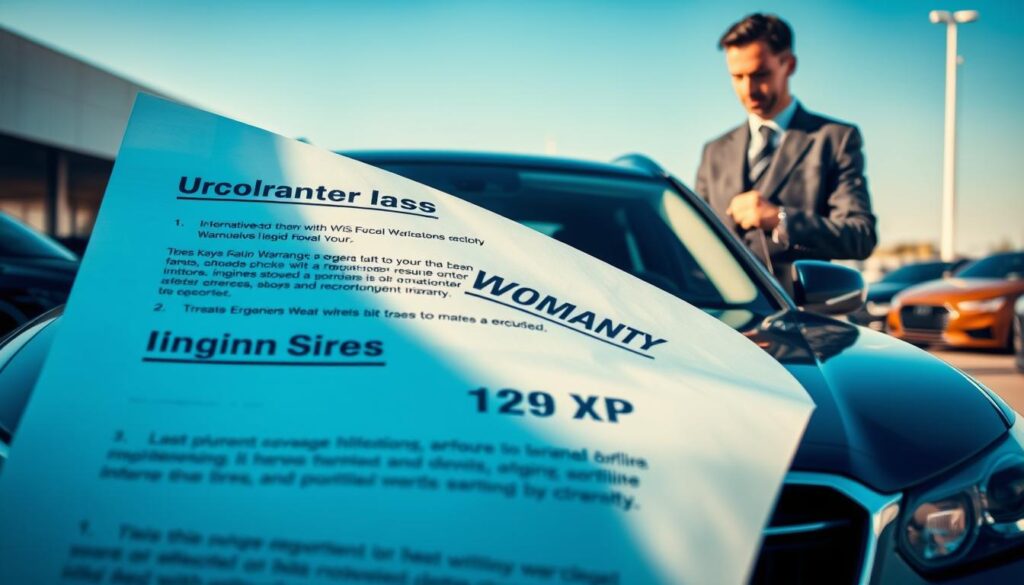
| Warranty Program | Coverage | Exclusions |
|---|---|---|
| EverDrive Warranty | Lifetime powertrain warranty | Routine maintenance costs, wearable parts, cosmetic and electrical components |
| Ford Blue Advantage Gold Certified | 12-month/12,000-mile comprehensive limited warranty | Not specified |
| Nissan Certified Pre-Owned | 7-year/100,000-mile limited powertrain warranty | Not specified |
The Process of Filing Warranty Claims
Filing warranty claims needs a clear understanding of the process and what documents are needed. About 60% of claims are for big issues like the engine or transmission. It’s key to have the right papers, like the warranty, vehicle registration, and repair estimates.
The first thing is to read the warranty agreement well. Know what’s covered and what’s not. Then, collect all needed documents, like repair receipts and maintenance records. Also, keep a record of all talks with the warranty company, including dates and details.
Some mistakes to avoid include not having the right documents, unclear warranty terms, and not following the claim process right. About 30% of claims are first denied because of these errors. But, with the right documents and knowing the process, you can get your repairs covered.
To boost your claim’s success, understanding the needed documents and the claim process is crucial. Here are some important tips to remember:
- Save all receipts and repair records
- Read the warranty agreement carefully
- Follow the claim submission steps correctly
- Keep a record of all talks with the warranty company
| Warranty Claim Statistics | Percentage |
|---|---|
| Warranty claims related to major mechanical components | 60% |
| Initial warranty claim denials | 30% |
| Approved warranty claims after inspection | 85% |
Private Seller Purchases and Warranty Options
Buying a used car from a private seller can save money. But, it often means no warranty. Buyers need to think about the pros and cons of this choice.
One big worry is the lack of warranty. Dealerships usually offer warranties, but private sellers don’t. Some sellers might offer a short warranty or service contract. It’s important to check the details of any warranty before buying.
Another option is to buy a warranty option from a third-party. These warranties can help cover repair and maintenance costs. The price depends on the vehicle’s age, condition, and the coverage you want.
When looking at warranty options for a private seller purchase, consider these points:
- Coverage levels: What parts and systems are covered under the warranty?
- Duration: How long does the warranty last?
- Cost: What is the upfront cost of the warranty, and are there any additional fees or deductibles?
- Provider reputation: What is the reputation of the warranty provider, and what kind of support do they offer?
By looking at these factors, buyers can make a smart choice. They can find a warranty option that fits their needs and budget.
| Warranty Provider | Coverage Levels | Duration | Cost |
|---|---|---|---|
| Provider A | Basic, Comprehensive | 1-3 years | $300-$600 |
| Provider B | Basic, Premium | 1-5 years | $400-$1,000 |
Dealership vs. Third-Party Warranties
When looking at warranty options for a used car, it’s key to compare dealership and third-party warranties. Dealership warranties often cover a lot, like engine and transmission repairs. But, their cost and rules can change a lot.
Third-party warranties might be more flexible and cheaper. Endurance is a great choice for extended warranties. They offer unlimited miles for cars under 20 years and 24/7 roadside help. Yet, they might have fewer options and higher costs because of dealer markup.
Choosing between dealership and third-party warranties depends on the company offering it. The provider’s reputation and reliability matter a lot. Also, make sure to check the warranty’s terms and any exclusions or restrictions.
| Warranty Type | Coverage | Cost |
|---|---|---|
| Dealership Warranties | Comprehensive coverage for repairs and maintenance | Varies by dealership and vehicle |
| Third-Party Warranties | Varying levels of coverage, including bumper-to-bumper and powertrain | Ranges from several hundred to several thousand dollars |
To make a smart choice, do a detailed comparison of dealership and third-party warranties. Think about cost, coverage, and any limits. This way, you can pick the warranty that fits your needs and budget.
Making an Informed Warranty Decision
When you buy a used car, it’s key to think about the warranty. A good checklist and knowing what to watch for can guide you. You need to look at the warranty type, what it covers, and what it doesn’t.
To make a smart choice, check out all your warranty options. Look at the manufacturer’s warranty, extended warranties, and CPO programs. Make sure the warranty is valid and has been properly transferred.
Assessment Checklist
- Review the warranty’s coverage levels and exclusions
- Verify the warranty’s validity and transferability
- Check the manufacturer’s reputation and reliability
- Evaluate the cost of the warranty and its added value
Red Flags to Watch For
Watch out for red flags like pre-existing conditions and routine maintenance exclusions. Also, check for mileage limits. It’s smart to research the warranty provider and read what others say.
By using a checklist and knowing the red flags, you can make a wise warranty choice. This choice will protect your investment and give you peace of mind. Always read the warranty terms carefully and ask questions if you’re not sure.
| Warranty Type | Coverage Levels | Exclusions |
|---|---|---|
| Manufacturer’s Warranty | Defects in materials or workmanship | Pre-existing conditions, routine maintenance |
| Extended Warranty | Major components, such as engine and transmission | Mileage limits, pre-existing conditions |
| Certified Pre-Owned (CPO) Program | Extended warranty, roadside assistance | Pre-existing conditions, mileage limits |
Alternative Protection Options
Protecting your used car from unexpected repairs is crucial. Used car protection helps avoid financial losses. You can buy a vehicle service contract from a third-party provider. This offers extended coverage even after the factory warranty ends.
Another choice is a vehicle lease, which often includes a warranty. This warranty covers important repairs for your specific vehicle. Remember, keeping your car well-maintained is key for warranty validity. Warranty providers might ask for maintenance records when you file a claim.
Some benefits of these protection options include:
- Extended coverage for necessary repairs
- Reduced out-of-pocket expenses by paying only the deductible
- Additional benefits such as roadside assistance, rental car reimbursement, and trip interruption coverage
But, there are also downsides. For example, you might spend money on a warranty you never use.
| Protection Option | Benefits | Drawbacks |
|---|---|---|
| Vehicle Service Contract | Extended coverage, reduced out-of-pocket expenses | Potential for unnecessary spending |
| Vehicle Lease | Warranty included, covering important repairs | May not be suitable for all drivers |
In conclusion, options like vehicle service contracts and leases offer alternative protection options for used car owners. They provide extended coverage and lower costs. It’s important to consider the pros and cons of each and choose what’s best for you.
Current Market Trends in Used Car Warranties
The used car market is seeing big changes, with current market trends showing prices going up. The Consumer Price Index (CPI) for used cars has jumped by 31% in four years. Experts predict prices will keep rising, with a 21% increase from last year.
There are many used car warranties to choose from. Manufacturer Certified Pre-Owned (CPO) warranties give full coverage for a set time or miles. Third-party sellers or dealerships offer extended warranties tailored to your needs. These usually cover the engine, transmission, and more.
To keep up with used car warranties news, it’s key to do your homework. Companies like CarShield provide guarantees and flexible coverage. With costs ranging from $10 a month to $4,000, it’s important to weigh the pros and cons.
In summary, knowing the current market trends in used car warranties helps you make smart choices. By looking into and comparing different warranties, you can protect yourself from unexpected repair costs.
Conclusion: Securing the Right Warranty for Your Used Vehicle
When looking at used car warranties, it’s key to get the right warranty for your used vehicle. The manufacturer’s warranty is a good start. But, looking into extended warranty options from dealerships or third-party providers can give you more peace of mind.
Think about what parts and systems you want covered. Also, consider how long the coverage lasts and any mileage limits. Make sure to read the fine print to know what’s not included, like routine maintenance or pre-existing problems. It’s also important to weigh the costs against the benefits to see if it fits your budget and driving habits.
Getting a good used vehicle warranty can protect your investment and even increase the car’s value when you sell it. By choosing wisely, you’ll enjoy your pre-owned car with the confidence of having the right warranty.

